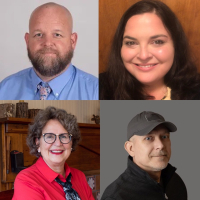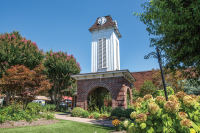Study finds success in amphibian pond project
 Take an evening walk through the woods this time of year, and odds are you’ll hear the grumpy quacking of a male wood frog, showing off for the ladies. The sound promises the return of warm days and growing gardens, even as icy temperatures fill the forecast.
Take an evening walk through the woods this time of year, and odds are you’ll hear the grumpy quacking of a male wood frog, showing off for the ladies. The sound promises the return of warm days and growing gardens, even as icy temperatures fill the forecast.
For Jessica Duke, this harbinger of a new season coincides with the end of an old. The Western Carolina University graduate student is wrapping up a year of study on behalf of local amphibian species like the wood frog, and what she’s found offers encouragement for animals that are up against some hard times.
The roots of Duke’s work began a decade ago, when Doreen Miller, who recently retired from the U.S. Forest Service, began building temporary ponds in the Nantahala National Forest in 2003. Wetlands are often the first habitats destroyed or damaged when human needs conflict with ecological ones, and for most amphibian species, they’re vital. Wetlands provide a place to mate and lay eggs, and for the tadpoles or larvae to grow into adults. The pools were intended as a low-maintenance way to fulfill these species’ habitat needs during the critical breeding season.
“The idea was to create pools that would dry in the late summer or early fall,” Duke said.
Spring rains would fill the ponds, and frogs and salamanders would have plenty of time to hatch and develop before the summer heat dried them. The only problem was that nobody really knew whether that’s what was actually happening.
Related Items
“Since the creation of most of the ponds, there’s been little follow-up monitoring,” Duke said.
So she did the only logical thing: At the suggestion of her advisor, WCU biology professor Joseph Pechmann, Duke brought her master’s thesis to the forest. Of the 60-plus ponds, she studied 50 in Macon and Jackson counties, visiting each during April and May 2013 to determine how many were actually capturing those spring rains. Half of them retained the water, so she visited that set of 25 three more times that year, taking data at each in late spring, early summer and late summer.
The goal was to figure out which species were using the ponds and to find out what characteristics were most important in making them amphibian-friendly. To that end, Duke looked at everything from the ponds’ depth, temperature, pH and surface area to their position on the landscape — elevation, slope, aspect, habitat type and shading. The species count, though, was the most telling measurement. Duke listed all the species that she might expect to show up to her study sites, a roll of 12. By the end of the summer, she knew who to mark absent.
“I found a lot of wood frogs, American toads, spring peepers,” she said.
Though 10 of the 12 species showed up, she didn’t find any mole salamanders or marbled salamanders. But those species tend to be rare in Nantahala National Forest anyway.
“If the salamanders were in the area of my created ponds, I’m confident that I would have found them using my ponds,” Duke said.
A hard knock life
The results are encouraging, Duke said, because amphibians sometimes have it tough. They breathe through their skin, so they’re susceptible to harm from any pollutants that find their way into the water they need to survive. They can have very specific environmental needs, so when temperature norms change or a wetland disappears, they have a hard time responding. Some fall prey to invasive species such as fire ants and feral hogs, and others are victims of poaching. But for Pechmann, these vulnerabilities are just part of what makes them so interesting.
“What draws me to amphibians is that they’re understudied creatures that often suffer from threats,” he said. “I’m also interested in complex life cycles, and they’re one of the flagship groups for complex life cycles.”
That’s a true enough statement. Frogs, for instance, hatch from their eggs as tadpoles. That larval stage can last upwards of four months. After that, it takes days or weeks longer for their legs to develop as their tails shrink away to nothing. Then there are salamanders, which may hatch either on land or in the water, depending on the species. Most go through a larval stage before growing into adults, but some skip that stage entirely and hatch as mini-adults. Others never fully assume an adult form. Some species live underwater until they leave as adults, while others live an entirely aquatic life.
The possibilities are dizzying, but not quite as dizzying as the sheer diversity of species, especially in this corner of the world.
“The Southern Appalachians have the highest diversity of salamanders in the world, depending on how exactly you count them,” Pechmann said. Western North Carolina has 48 species of salamander and 11 of frogs. And those numbers keep growing — though locally the growth is limited mainly to salamanders — because modern DNA testing now allows biologists to distinguish nearly identical-looking organisms into different species.
“To identify some of them, you need a map and a GPS,” Pechmann said.
Splashing toward an amphibious future
Duke, though, had a pretty good bead on which species she was looking for. Of the 25 water-holding ponds she studied, 22 contained amphibian species, including the larval stages that indicated they were able to breed there.
Those numbers, Duke said, indicated that Miller’s original pond project was “pretty overall effective.” Salamanders, toads and frogs were using them during mating season, as intended, producing a new generation of offspring. Though no vegetation was planted when the ponds were created, an impressive diversity of plant life grew up around them — Duke counted 34 different aquatic plant species. And all this happened without tying Forest Service employees up in an endless cycle of construction and maintenance.
“They actually, to my knowledge, have not returned to any of those ponds,” Duke said.
But Duke’s results also showed her some ways the Forest Service might be more successful in building future ponds. Her recommendations started with those 25 ponds that weren’t holding water at the beginning of the season. No water means no breeding, and a pond that dries up too quickly means desiccated tadpoles on the forest floor. It’s no surprise, then, that ponds that held water longer were more successful amphibian breeding grounds. The question is, how do you build a temporary pond that’s not too temporary to function?
“So far, it looks like landscape position is a big factor in how long the pond holds water,” Duke said. Characteristics like whether a pond faces north or south, how much of it is shaded by trees and what kind of slope it’s on all feed in to how long that pond is able to stick around, and ultimately, how much good it does for a frog looking for a place to woo his honey.
“I hope I can provide good feedback to overall future creation of these ponds,” Duke said.
The overall goal, of course, is to offer one more avenue for these little-noticed creatures to continue making their home in the Smokies. They may not be as conspicuous as black bears or as charismatic as elk, but the Smokies without its amphibian residents wouldn’t be the Smokies at all, Pechmann said.
“I think they add to our experience and our quality of life, even if we don’t spend a lot of time looking at them,” he said. “An analogy is that different species are like the instruments in a symphony. If you took away the French horn, you may not notice it that much. If you took away the trumpet, you would notice it a little bit more. If you took away the brass section, it wouldn’t sound quite as good.”
Meet the neighbors
Amphibians can be easy to miss. They’re usually small creatures — with the notable exception of the hellbender, which can reach two feet in length — and live hidden lives under rocks and beneath streambeds. But you might be surprised how easy it is to get to know your slimy-skinned neighbors.
This time of year, frogs are your best bet for an amphibian sighting. Wood frogs are already calling, and spring peepers start sounding soon. Before you know it, the evening will be full of froggy choruses. Venture out at night, preferably after a rain when the temperature is over 50 degrees, and you’ll likely have luck. Frogs especially like to hang out at woodland ponds, so seek out some waterways and bring a flashlight if you’d like to see one, rather than just hear the chorus. And if you’re wanting to bone up on your frog call repertoire beforehand? Visit www.herpsofnc.org and click through their frog call library.
And as the weather gets even warmer, you can look around for salamanders. On a warm, damp night, seek out the higher elevations and shine a headlamp around. Look carefully, and you’ll probably see some crawling. Or if you’d rather embark on a daytime excursion, head out to the woods and turn over rocks in small streams and on the forest floor. But remember to be a good neighbor.
“You want to remember to put the rocks back so you don’t wreck their homes,” Pechmann said.









